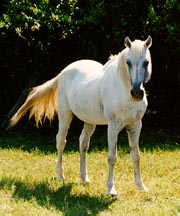Florida Cracker
N/A
Tue, 15th April, 2025 - 8:41 am GMT
Sponsor Ads:

Alternative Name
N/ABasic Info
Florida Cracker horses are small saddle horses, standing 13 to 15.2 hands at the withers and weighing 650-900 pounds. The head is refined and intelligent in appearance. The profile is straight or slightly concave. The throat latch is prominent and the jaw is short and well-defined. The eyes are very keen with an alter expression and have reasonable width between them. The eye colors are dark, with a white sclera, gray or blue. The neck is well-defined, fairly narrow, without excessive crest and is about the same length as the distance from the withers to the croup. The back is short, narrow and strong with well sprung ribs. The croup is sloping and short. Tail is set medium low. The breed is found in any color common to the horse, however, solid colors and grays predominate. Enticing leads of paint and roan strains still persist, and these other colors (historically present in the breed) may yet be located in some remote corner of Florida. While this external type is distinctive, breed proponents insist that the best way to tell a Florida Cracker horse is to ride one, for its easy, ground covering gaits are rarely found in other breeds. The gaits include the flatfoot walk, running walk, trot and ambling or Paso-type gait
Health
N/AHabitat
N/ABehavior
Cracker Horses are willing workers whose action shows spirit, not laziness.Origin
FloridaHistory
The Florida Cracker horse, like the cattle breed of the same name, traces its ancestry to Spanish stocks brought to the Americas beginning in the 1500s. The formation of the Cracker horse breed was parallel to that of the Spanish Mustang and Spanish Barb further west. The Cracker became a distinctive part of this breed family due to its geographical isolation and location. The long history of horse trading between Florida and Cuba meant a regular and continual introduction of Spanish genetics from Cuba into the Florida population. Historically, Cracker horses were an essential part of the cattle industry in Florida, which began almost 500 years ago and flourishes today. Florida cowboys were nicknamed "crackers" because of the sound made by their whips cracking in the air. This name was also given to the small, agile Spanish horses that were essential for working Spanish cattle. Over the years, Cracker Horses have been known by a variety of names: Chicksaw Pony, Seminole Pony, March Tackie, Praire Pony, Florida Horse, Florida Cow Pony, Grass Gut and others. The Cracker horse suffered a reversal of fortune in the 1930s. The Great Depression led to the creation of a number of relief programs, one of which encouraged the movement of cattle from the Dust Bowl into Florida. With the cattle came the screwworm parasite, and this changed the practice of cattle raising. Before the screwworm, cowboys used horses to herd and drive cattle; with the arrival of the screwworm came the need to rope cattle and hold them for veterinary treatment. As a result, ranchers turned to the larger, stronger Quarter Horse, and the Florida Cracker horse became quite rare. The breed's survival over the last fifty years resulted from the work of a few families who kept distinct blood lines alive in their herds. Several of these lines -- such as Ayers, Harvey, Bronson, and Whaley -- are still very important within the breed. The Florida Cracker Horse Association was organized in 1989, with its first task the search for remnant herds of Cracker horses. A registry was established, and foundation animals were registered based on their history and external type. Stringent application of the rules has resulted in a very consistent breed. Today, the Florida Cracker is promoted as a valuable and vital part of Florida's heritage, though it is still quite rare with almost 300 horses having been included in the registry.Common Foods
grassSponsor Ads:
If violence is the last refuge of the incompetent, religion is the second last. -- Dan & Kier
Florida Cracker
Coded by: BGID® | ALL RIGHTS RESERVED Copyright © 2000-2025
Disclaimer | Privacy | Report Errors / Contact | Credits
















